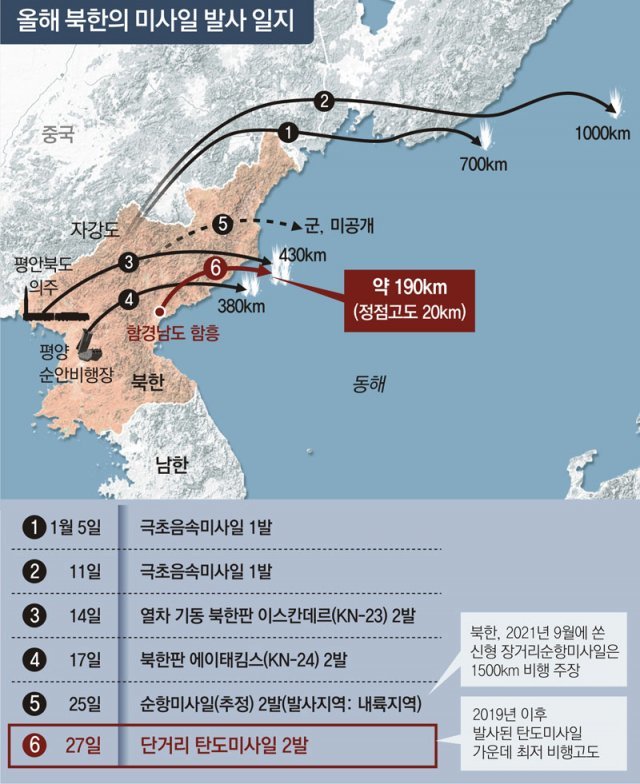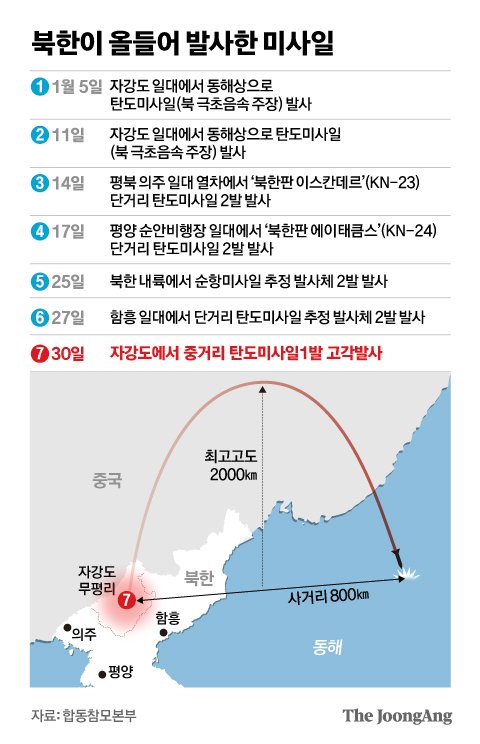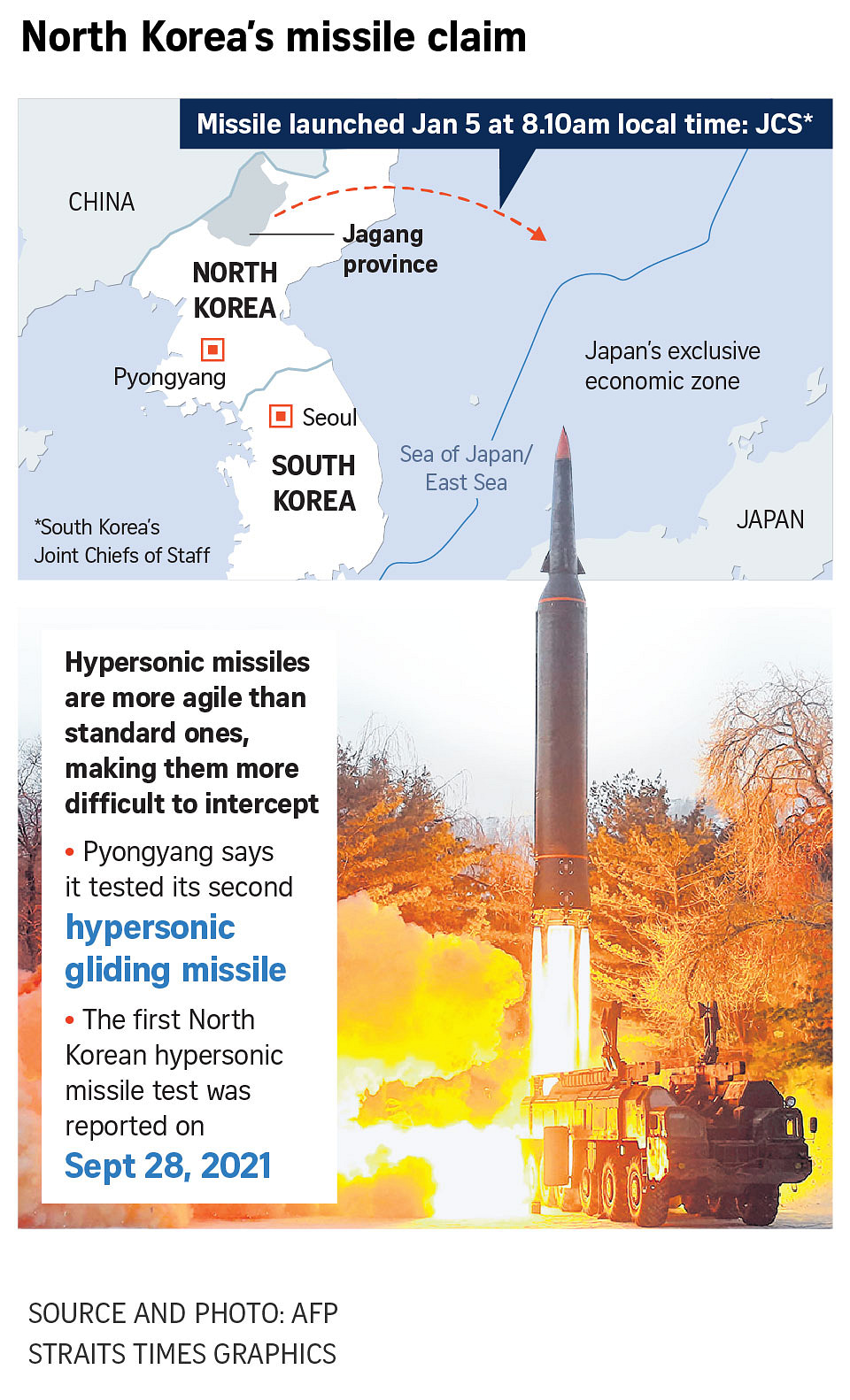Jan. 5, 2022
Around 08:10 a.m.(KST), North Korea fired a hypersonic missile into the East Sea from Mupyung-ri, the Jagang Province area. Japan's Defense Ministry said a ballistic missile had flown about 500 km before landing in waters outside Japan's exclusive economic zone.
Hypersonic glide missiles can avoid detection longer than ballistic missiles because they fly towards targets at lower altitudes(thereby evading radar systems) at 6,200 km per hour or five times the speed of sound.
North Korea had not responded to repeated calls from South Korea and the United States to return to denuclearization talks. The Biden administration said he would meet North Korea "anytime, anywhere" without preconditions.
KCNA, North Korea's state-run media, reported that the hypersonic gliding warhead detached from the missile and flew 120km laterally before it precisely hit its target 700km away.
This ballistic missile launch - the first in 2022- came 78 days after the North's last missile test(SLBM) on Oct. 19, 2021. In 2021, the Kim Jong-un regime tested a new SLBM, long-range cruise missiles, a train-launched ballistic missile, and a hypersonic missile. (source: The Korea Herald, Korea Joongang Daily, Strait Times)
Jan. 11, 2022
At 7:27 a.m., North Korea conducted the second consecutive test-firing of a hypersonic missile into the East Sea from Jagang Province near China.
The missile flew over 700 km at a top altitude of 60 km and a maximum speed of Mach 10. The South Korean Joint Chiefs of Staff said it was more advanced than Jan. 5. The JCS said that North Korea's ballistic missile launches violated UN Security Council resolutions.
Hypersonic missiles were developed to avoid interception. Only a few countries have them, such as the United States, Russia, and China.
The North Korean state media claimed that the country test-fired an identical maneuverable reentry vehicle(MaRV) to the one launched on Jan. 5. According to KCNA, the hypersonic vehicle made a glide jump flight from 600 km, followed by 240 km of corkscrew maneuvering before hitting the set target in waters 1,000 km away.
The White House condemned North Korea, saying that the launch highlights the destabilizing impact of the DPRK's illicit weapons program. On Jan. 12, the U.S. Treasury and State Department announced sanctions targeting six North Koreans, one Russian national, and a Russian entity responsible for procuring goods for North Korea's WMD and ballistic missile programs. (source: The Korea Herald)
 |
| [ North Korea's Hypersonic Missile Fire(KCNA) ] |
North Korea conducted its railway-based two tactical guided missile test. South Korea's Joint Chiefs of Staff (JCS) said that the missiles flew around 430 kilometers eastward at an altitude of 36 kilometers from Pihyon, North Pyongan Province. The first missile launch was detected at 2:41 p.m. and the other at 2:52 p.m. According to the military, the missiles flew at a top speed of around Mach 6. Train-borne launchers enhance the North's ability to fire missiles without prior detection by South Korean and U.S. intelligence.
The state-run Korean Central News Agency(KCNA) reported on Jan. 15 that the North Korean military's railway-based missile regiment conducted Friday's drill to check and judge the proficiency of the unit's capabilities. (source: Korea Joongang Daily)
 |
(source : Donga-ilbo) |
'
Jan. 17, 2022
North Korea fired two tactical guided short-range ballistic missiles from Sunan Airfield in Pyongyang at 8:50 a.m. and 8:54 a.m.(KST). They flew 380 km (236 miles), reaching a maximum altitude of 42 km, according to the South Korean Joint Chiefs of Staff(JCS). The travel distance is approximately equidistant from the launch site to the South Korean Army, Navy, and Air Force Headquarters in Gyeryong, South Chungcheong Province. The test was the fourth in an unusual spate of launches within the last two weeks.
KCNA suggested that North Korea testified KN-24 short-range ballistic missiles, which look similar to the US MGM-140 Army Tactical Missile System, or ATACMS. The KN-24 single-stage solid-propellant missile is a tactical system with a mobile launcher. The KN-24 reportedly performs "pull-up maneuvers" in flight to avoid interception and can carry out a precision strike with its guidance system and in-flight maneuverability. (source: Korea Joongang Daily)
 |
Fire of Tactical Guided Missiles(KCNA) |
 |
(source: Joongang-ilbo) |
Jan. 25, 2022
North Korea fired at least two suspected cruise missiles from an inland area, without specifying where, and landed in the East Sea, South Korean military authority said. According to the KNCA, the long-range cruise missiles flew for 9,137 seconds and hit a target island 1,800 kilometers away. Cruise missile launches are not covered by United Nations Security Council resolutions that govern Pyongyang's weapons activity. (source: Yonhap News Agency, Japan Times)
 |
Cruise missiles launches by North Korea(KCNA) |
Jan. 27, 2022
North Korea fired two short-range ballistic missiles from Hamhung, South Hamgyong Province toward its east coast at 8:00 a.m. and 8:05 a.m.(KST). They landed 190 kilometers (118 miles) away in the sea after reaching an altitude of 20 kilometers.
The main goal of the low-altitude flight test would be to enable a projectile to fly below interceptors' minimum intercept altitude and to penetrate and incapacitate the ballistic missile defense system. North Korea chose Hamhung, a city on the east coast, to secure the safety of the test firing because a lower altitude could lead to a greater risk of coming down.
According to a South Korean military official, two missiles were presumed to have hit a target on the small uninhabited island of Al. North Korea previously set a target on the same island when firing KN-23 and KN-24 short-range ballistic missiles on Jan. 14 and 17. (source: Korea Joongang Daily, Korea Herald)
 |
SRBM launches by North Korea(KCNA) |
 |
(source: Donga-ilbo) |
Jan. 30, 2022
North Korea test-fired a Hwasong-12 intermediate-range ballistic missile(IRBM). It was the same weapon the North had once threatened to target the U.S. territory of Guam.
The IRBM was fired from Mupyong-ri in Jagang Province, near the border with China, into the East Sea at 7:52 a.m., according to South Korea's Joint Chiefs of Staff. It was fired at a steep angle and flew about 800 kilometers (497 miles) with a top altitude of 2,000 kilometers.
It marked the unpredictable North's seventh show of force in January 2022. And it was the first time a nuclear-capable missile of that size had been launched since 2017. According to analysts, seven North Korean missile tests in the first four weeks of 2022 suggested that Kim Jong-un was striving to meet domestic goals and to show his power and influence to the world.
The UN Security Council's meeting on Feb. 4 in response to a Hwasong-12 IRBM on Jan. 30 ended without additional sanctions against North Korea. China and Russia, along with other nations, refused to give their approval. Two other UNSC meetings in Jan. were in vain. (source: Korea Joongang Daily, CNN)
 |
| (source : Joongang-ilbo) |







Comments
Post a Comment